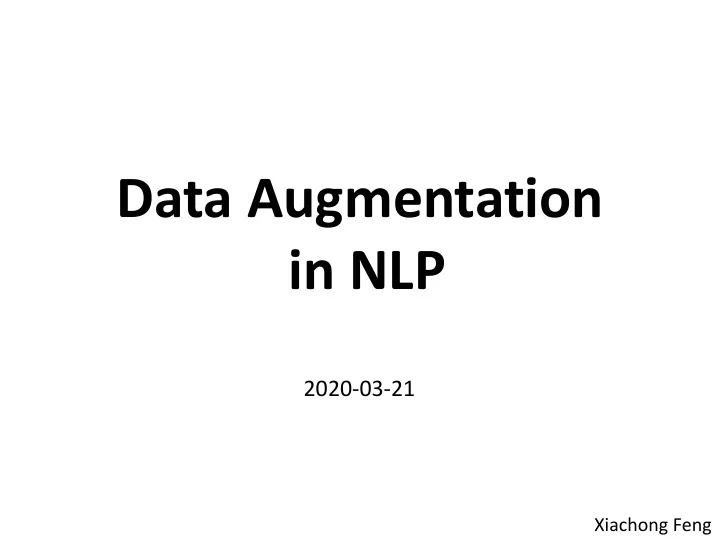

Data Augmentation in NLP 2020-03-21 Xiachong Feng
Outline • Why we need Data Augmentation? • Data Augmentation in CV • Widely Used Methods • EDA • Back-Translation • Contextual Augmentation • Methods based on Pre-trained Language Models. • BERT • GPT • Seq2Seq (BART) • Conclusion
Why we need Data Augmentation? • Few-shot Learning • Imbalance labeled data • Semi-supervise Learning • ...... https://mp.weixin.qq.com/s/CHSDi2LpDOLMjWOLXlvSAg
Data Augmentation in CV Scale Flip : flip images horizontally and vertically. Rotation Crop : randomly sample a section from the original image Gaussian Noise https://medium.com/nanonets/how-to-use- deep-learning-when-you-have-limited-data- part-2-data-augmentation-c26971dc8ced
IF we apply them to NLP I hate you ! ! you hate I Flip : flip horizontally and vertically. I hate you ! I hate you ! I hate you ! Crop : randomly sample a section Language is Discrete.
Widely Used Methods • EDA • Back-Translation • Contextual Augmentation
EDA • EDA: Easy Data Augmentation Techniques for Boosting Performance on Text Classification Tasks 1. Synonym Replacement (SR): Randomly choose n words from the sentence that are not stop words. Replace each of these words with one of its synonyms chosen at random. 2. Random Insertion (RI): Find a random synonym of a random word in the sentence that is not a stop word. Insert that synonym into a random position in the sentence. Do this n times. 3. Random Swap (RS): Randomly choose two words in the sentence and swap their positions. Do this n times. 4. Random Deletion (RD): Randomly remove each word in the sentence with probability p.
EDA Examples
Conserving True Labels ?
Back-Translation English Chinese English
Back-Translation Model(E->C) English Chinese English Chinese Model(E->C) Chinese English Chinese English
Contextual Augmentation • Contextual Augmentation: Data Augmentation by Words with Paradigmatic Relations NAACL18 • Disadvantages of the Synonym Replacement • Snonyms are very limited. • Synonym-based augmentation cannot produce numerous different patterns from the original texts.
Contextual Augmentation the performances are fantastic the performer are fantastic the films are fantastic the actress are fantastic the movies are fantastic the stories are fantastic Synonym Replacement Contextual Augmentation the actors are fantastic
Contextual Augmentation Sample Bi-directional LSTM-RNN Pretrained on WikiText-103 corpus
Contextual Augmentation positive the actors are good positive the actors are entertaining the actors are bad the actors are terrible positive the actors are fantastic
Contextual Augmentation Further trained on each labeled dataset
Others • Variational Auto Encoding (VAE) • Paraphrasing • Round-trip Translation • Generative Adversarial Networks (GAN)
Methods based on Pre-trained Language Models • Conditional BERT Contextual Augmentation ICCS19 • Do Not Have Enough Data? Deep Learning to the Rescue! AAAI20 • Data Augmentation using Pre-trained Transformer Models Arxiv20
Methods based on Pre-trained Language Models From Pre-trained Models for Natural Language Processing: A Survey
Conditional BERT Contextual Augmentation ICCS19 Xing Wu, Shangwen Lv, Liangjun Zang, Jizhong Han, Songlin Hu, Institute of Information Engineering, Chinese Academy of Sciences, Beijing, China University of Chinese Academy of Sciences, Beijing, China
BERT BERT: Pre-training of Deep Bidirectional Transformers for Language Understanding
C-BERT
Do Not Have Enough Data? Deep Learning to the Rescue ! AAAI20 Ateret Anaby-Tavor, Boaz Carmeli, Esther Goldbraich, Amir Kantor, George Kour, Segev Shlomov, Naama Tepper, Naama Zwerdling IBM Research AI, University of Haifa, Israel, Technion - Israel Institute of Technology
LAMBADA • language-model-based data augmentation (LAMBADA) • Disadvantages of the Contextual Augmentation • Presumably, methods that make only local changes will produce sentences with a structure similar to the original ones, thus yielding low corpus-level variability
GPT https://gpt2.apps.allenai.org/?text=Joel%20is%20a
LAMBADA • The generative pre-training (GPT) model
LAMBADA label sentence label sentence label sentence
LAMBADA • Filter synthesized data Confidence Score
Data Augmentation using Pre- trained Transformer Models Arxiv20 Varun Kumar, Alexa AI Ashutosh Choudhary, Alexa AI Eunah Cho, Alexa AI
Pre-trained Language Models From Pre-trained Models for Natural Language Processing: A Survey
Pre-trained Language Models BERT GPT-2
Pre-trained Language Models • BART: Denoising Sequence-to-Sequence Pre-training for Natural Language Generation, Translation, and Comprehension
Unified Approach autoencoder (AE) LM: BERT auto-regressive (AR) : GPT2 seq2seq model: BART
Add Labels : Expend treats a label as a single token interesting
Add Labels : Prepend the model may split label into multiple subword units ing interesting interest + ing fascinating fascinat + ing disgusting disgust +
Fine-tuning Type PLM Task Labels Model Description prepend BERT prepend AE BERT MLM expand BERT expand
Fine-tuning Type PLM Task Labels Model Description prepend BERT prepend AE BERT MLM expand BERT expand GPT2 𝑧 " 𝑇𝐹𝑄 LM AR GPT2 prepend ( 𝑧 ! 𝑇𝐹𝑄𝑦 ! 𝐹𝑃𝑇 … ) GPT2 context 𝑧 " 𝑇𝐹𝑄𝑥 ! 𝑥 # 𝑥 $
Fine-tuning Type PLM Task Labels Model Description prepend BERT prepend AE BERT MLM expand BERT expand GPT2 𝑧 " 𝑇𝐹𝑄 LM AR GPT2 prepend ( 𝑧 ! 𝑇𝐹𝑄𝑦 ! 𝐹𝑃𝑇 … ) GPT2 context 𝑧 " 𝑇𝐹𝑄𝑥 ! 𝑥 # 𝑥 $ Replace a token BART word with mask Seq2Seq BART Denoising prepend Replace a BART span continuous chunk words
Algorithm
Experiments • Baseline • Task • EDA • Sentiment Classification (SST2) • Intent Classification (SNIPS) • C-BERT • Question Classification (TREC) five validation examples per class
Experiments Extrinsic Evaluation Intrinsic Evaluation Sentiment Classification • Semantic Fidelity • Intent Classification • Text Diversity • Question Classification •
Extrinsic Evaluation • Pre-trained BERT classifier
Semantic Fidelity • Training + Test dataset à BERT classifier
Text Diversity
Conclusion • Data augmentation is useful. • EDA, Back-translation,...... • PLM can be used for data augmentation. • Generate new data is powerful than the replace- based method. • Data Augmentation for Text Generation?
Thanks!
Recommend
More recommend